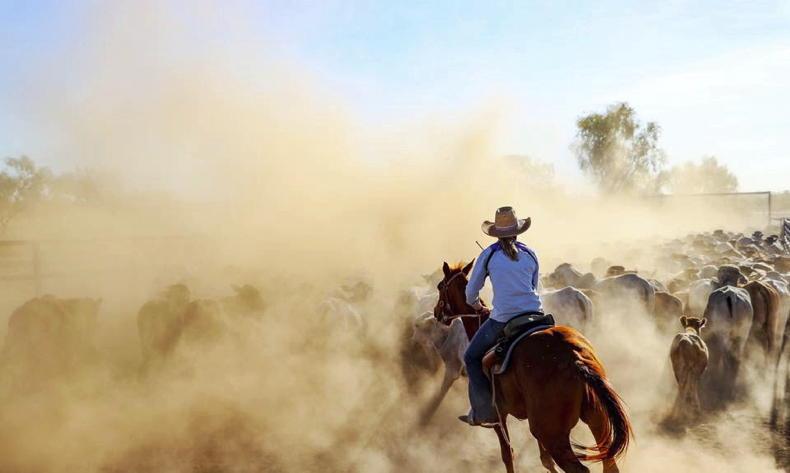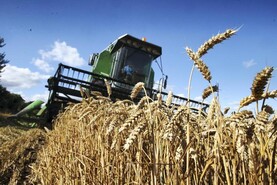Farmers in Australia are set to see their incomes nosedive some 41%, according to a new report by the Australian Bureau of Agricultural and Resource Economics and Sciences (ABARES).
In its forecast for farm performance in 2023-2024 and updated figures for 2022-2023, the bureau used market analysis, long-term seasonal weather forecasts and related crop and pasture growth estimates.
After two record years for Australian farmers, farm incomes are forecast to fall significantly in 2023-2024. At a national level, average farm income for broadacre farms is expected to decrease 41% to $197,000 per farm.
A broadacre farm is defined as a land parcel greater than 4,000 square metres (1ac).
Outlook
The income slide will be down to reduced prices for agricultural commodities - particularly livestock - and declines in crop production due to drier conditions next year, according to the bureau’s outlook.
Livestock farms will be affected by large decreases in prices for beef cattle and sheep, with sheep farm incomes in particular forecast to be well below average in 2023-2024.

The ABARES has forecast a 38% decrease in sheep farm incomes.
Incomes for beef farms are forecast to come down 27% to $132,000, but remain in line with the long-term average for beef farms, after record incomes in 2020-2021 and 2021-2022.
Although beef cattle sales are forecast to increase in 2023-2024, this is more than offset by declining beef prices.
Further declines in sheep and lamb prices are forecast in 2023-2024 as well, while wool prices are forecast to remain low in real terms.
Low prices are leading to a forecast 38% decrease in sheep farm incomes to $36,000 in 2023-2024.
Tillage
Incomes for Australian tillage farms are forecast to decline by 45% to an average of around $627,000 nationally in 2023-2024.
This comes off the back of 2021-2022 and 2022-2023 being two of the best years on record for tillage farm incomes, with favourable climate conditions and commodity prices.

Incomes for Australian tillage farms are forecast to decline by 45%.
Due to drier conditions, production for major winter crops is forecast to fall significantly in 2023-2024.
Declines in national production of wheat (36%), barley (26%) and oilseeds (38%) are driving reduced crop revenue.
However, strong soil moisture to start the season means that crop production is predicted to remain around the long-term average.
Farmers in Australia are set to see their incomes nosedive some 41%, according to a new report by the Australian Bureau of Agricultural and Resource Economics and Sciences (ABARES).
In its forecast for farm performance in 2023-2024 and updated figures for 2022-2023, the bureau used market analysis, long-term seasonal weather forecasts and related crop and pasture growth estimates.
After two record years for Australian farmers, farm incomes are forecast to fall significantly in 2023-2024. At a national level, average farm income for broadacre farms is expected to decrease 41% to $197,000 per farm.
A broadacre farm is defined as a land parcel greater than 4,000 square metres (1ac).
Outlook
The income slide will be down to reduced prices for agricultural commodities - particularly livestock - and declines in crop production due to drier conditions next year, according to the bureau’s outlook.
Livestock farms will be affected by large decreases in prices for beef cattle and sheep, with sheep farm incomes in particular forecast to be well below average in 2023-2024.

The ABARES has forecast a 38% decrease in sheep farm incomes.
Incomes for beef farms are forecast to come down 27% to $132,000, but remain in line with the long-term average for beef farms, after record incomes in 2020-2021 and 2021-2022.
Although beef cattle sales are forecast to increase in 2023-2024, this is more than offset by declining beef prices.
Further declines in sheep and lamb prices are forecast in 2023-2024 as well, while wool prices are forecast to remain low in real terms.
Low prices are leading to a forecast 38% decrease in sheep farm incomes to $36,000 in 2023-2024.
Tillage
Incomes for Australian tillage farms are forecast to decline by 45% to an average of around $627,000 nationally in 2023-2024.
This comes off the back of 2021-2022 and 2022-2023 being two of the best years on record for tillage farm incomes, with favourable climate conditions and commodity prices.

Incomes for Australian tillage farms are forecast to decline by 45%.
Due to drier conditions, production for major winter crops is forecast to fall significantly in 2023-2024.
Declines in national production of wheat (36%), barley (26%) and oilseeds (38%) are driving reduced crop revenue.
However, strong soil moisture to start the season means that crop production is predicted to remain around the long-term average.








 This is a subscriber-only article
This is a subscriber-only article










SHARING OPTIONS: